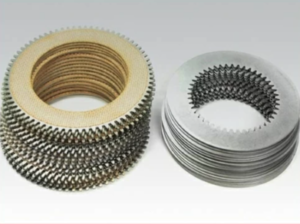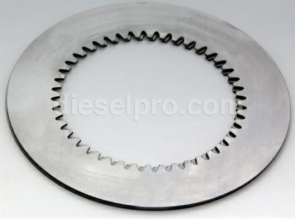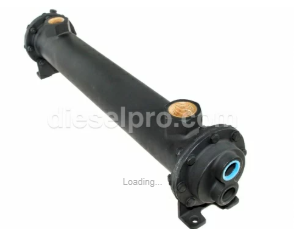

Parts Catalog for Twin Disc MG5090A Marine Transmissions
Overhaul Plate Kit For Twin Disc MG5090A Marine Transmission
Gasket Kits For Twin Disc MG5090A Marine Transmission
Introduction to Inspection Protocols for Twin Disc MG-5090A Marine Gear
Proper inspection procedures are essential to maintaining the longevity and performance of the Twin Disc MG-5090A marine transmission. Whether you’re conducting daily checks, a 250-hour service, or a 3,000-hour overhaul, a systematic inspection routine can help detect early signs of wear, prevent costly downtime, and reduce the risk of catastrophic failure. This guide provides detailed protocols for inspecting key components, identifying abnormal wear patterns, and using the right tools—like borescopes, torque wrenches, and pressure gauges—for accurate results.
These procedures are designed for fleet mechanics, marina operators, and individual vessel owners who maintain their own systems. For advanced diagnostics and internal measurements, always refer to the Twin Disc MG-5090A OEM service manual or consult a certified technician.
General Principles of Routine Inspection for Twin Disc MG-5090A Marine Gear
Routine inspections are not just about looking for visible issues—they’re about trend analysis, preventive action, and safety assurance.
Inspection Goals:
- Verify system functionality
- Prevent unscheduled repairs
- Detect early-stage failures
- Ensure compliance with maintenance schedules
- Maintain resale value
Inspection Frequency Guidelines:
Inspection Type |
Interval |
| Visual check | Before every trip |
| Basic inspection | Every 250 hours / 3 months |
| Intermediate inspection | Every 1,000 hours / 12 months |
| Full internal inspection | Every 3,000 hours / 36 months |
Let’s now break down the critical elements of each scheduled inspection.
Oil Condition Evaluation for Twin Disc MG-5090A Marine Gear
Transmission oil serves both as a hydraulic medium and a lubricant. Its condition reveals more than just lubrication status—it can indicate internal component wear, overheating, or water contamination.
What to Check:
- Color:
- Clear amber = Normal
- Dark brown/black = Overheating or oxidation
- Milky = Water intrusion
- Grayish = Possible metal particle contamination
- Smell:
- Burnt odor = Clutch friction material degradation
- Sour or fuel-like = Cross-contamination from adjacent systems
- Viscosity:
- Should match spec at operating temperature
- Excessively thin oil suggests dilution or thermal breakdown
Tools Needed:
- Oil sample extraction pump
- Clear sampling bottle
- Oil analysis test kit (optional)
Action Steps:
- If oil is milky, immediately check for failed oil cooler or seal leaks.
- If burnt, inspect clutch packs and verify hydraulic pressure.
- Always change oil if any abnormalities are detected.
Vibration Analysis for Twin Disc MG-5090A Marine Gear
Unusual vibration is often a symptom of underlying mechanical issues. A methodical approach to vibration inspection will help you identify whether the source is misalignment, gear wear, or bearing degradation.
Inspection Points:
- Operational Check:
- Run the engine at idle and cruising RPM.
- Observe the transmission casing, mounts, and shaft.
- Use a Vibration Analyzer (Optional):
- Check axial and radial vibration at input/output shafts.
- Compare readings to previous logs or baseline values.
- Physical Checks:
- Inspect flexible coupling for wear or cracking.
- Check engine and transmission mounts for deterioration.
- Use a dial indicator to check shaft runout.
Possible Causes of Vibration:
- Misaligned propeller shaft
- Gear tooth wear or backlash
- Damaged bearings
- Loose mounts or structural fasteners
Correction:
- Re-align shafts to within 0.002” tolerance.
- Replace worn mounts or gears as necessary.
- Rebalance props and check drive flanges for runout.
Engagement Lag Detection in Twin Disc MG-5090A Marine Gear

Delayed engagement of forward or reverse gear is often the first sign of hydraulic system issues or clutch wear.
Symptoms:
- Engine revs increase before transmission responds
- Transmission shifts harshly or slowly
- Occasional failure to engage until multiple attempts
Root Causes:
- Low hydraulic oil level or pressure
- Worn clutch friction discs
- Clogged oil passages or dirty valve body
- Weak return springs in clutch piston assembly
Inspection Process:
- Verify Oil Level and Quality
- Pressure Test:
- Connect a pressure gauge to the clutch test port.
- Record pressure during forward and reverse engagement.
- Compare against OEM pressure specs (e.g., 250–300 PSI typical range).
- Check Linkages or Electronic Shift Signals:
- Manual lever: Ensure full travel and no obstructions.
- Electronic shift: Verify control module and solenoid function.
- Use Borescope to View Clutch Area:
- Look for signs of scorching, oil leaks, or debris.
Recommendation:
- If engagement lag exceeds 1–2 seconds, schedule a clutch inspection and pressure test immediately.
Oil Leak Inspection for Twin Disc MG-5090A Marine Gear

Oil leaks not only reduce operating efficiency—they create fire hazards, environmental violations, and increase wear on internal components.
High-Risk Areas for Leaks:
- Input Shaft Seal
- Output Shaft Seal
- Inspection Cover Gaskets
- Cooler Line Connections
- Drain Plug and Sight Glass
- Control Valve Body Mating Surfaces
Inspection Tools:
- Flashlight and inspection mirror
- Clean lint-free cloth
- UV dye tracer kit (optional)
Steps:
- Wipe all suspected areas clean
- Run the transmission under load for 15–30 minutes
- Reinspect for seepage or active leaks
- Use UV light if dye is present
Severity Guide:
Leak Type |
Action Needed |
| Weeping/seepage | Monitor; reseal at next service |
| Active drip | Schedule immediate gasket/seal replacement |
| Pooled oil | Shut down, inspect, and repair before operation |
Tip: Always replace any degraded gaskets or O-rings during routine oil changes to prevent future leaks.
Bolt Torque Inspection for Twin Disc MG-5090A Marine Gear
Loose bolts can cause misalignment, fluid leaks, or catastrophic gear misengagement. Each visible fastener should be checked periodically with a calibrated torque wrench.
Critical Bolt Locations:
- Mounting Bolts to Engine Block
- Inspection Cover Bolts
- Output Flange Bolts
- Oil Filter Housing
- Control Valve Bolts
Torque Tools:
- Inch-pound and foot-pound torque wrenches
- Twin Disc torque spec chart (from OEM manual)
Process:
- Verify current torque with click or beam-type wrench.
- Loosen and retorque bolts in proper sequence if any exceed spec.
- Apply medium-strength threadlocker (e.g., Loctite 242) if removed.
Caution: Do not exceed torque specs—over-tightening may crack housing or strip threads.
Internal Inspection Using a Borescope for Twin Disc MG-5090A Marine Gear

For high-quality inspections without full disassembly, a borescope or inspection camera can reveal internal clutch, gear, and bearing conditions.
Equipment:
- 4–6mm diameter borescope with articulating head
- High-resolution camera and screen or wireless link
- LED light source
Entry Points:
- Inspection cover port
- Oil fill opening (if large enough)
- Custom plug or test port access
What to Look For:
- Clutch discs: Signs of discoloration, scoring, or uneven wear
- Gear teeth: Pitting, galling, or abnormal wear
- Bearings: Any signs of discoloration, overheating, or debris
- Foreign Objects: Metal shavings, loose parts, or debris buildup
Best Practice: Document images for trend analysis and reference during future service.
Inspection of Control Linkages and Shift Mechanisms
Whether manual or electronically actuated, shift systems must engage cleanly and reliably.
Manual Linkage Checks:
- Ensure full travel between forward, neutral, and reverse
- Check for binding, corrosion, or cable stretching
- Lubricate pivot points and cable ends
Electronic Controls:
- Verify signal continuity with a multimeter
- Test solenoid response with 12V source or control panel
- Inspect wiring harnesses for chafing or corrosion
Note: Inconsistent or delayed shifting may originate from the control system, not the transmission itself.
Propeller Shaft and Output Coupling Inspection

The health of the output shaft and coupling affects noise levels, wear, and alignment.
Inspection Areas:
- Flexible Coupling Condition
- Shaft Runout
- Keyway or Spline Wear
- Coupling Bolt Torque
Tools:
- Dial indicator with magnetic base
- Torque wrench
- Straightedge or feeler gauge for shaft alignment
Red Flags:
- Polished or damaged keyways
- Fretting corrosion on coupling face
- Excessive backlash or shaft movement
Correction: Replace flexible elements, rebalance shaft, or align flanges to spec.
Bushing, Mount, and Structural Inspection
Soft mounts isolate vibration between engine, transmission, and hull. Degradation here causes excessive movement and load transfer.
Inspection Checklist:
- Check for cracked rubber or broken steel mount shells
- Use pry bar to test for excessive play
- Verify mount height and bolt torque
Service Tip: Always replace mounts in pairs to maintain alignment.
Checklist Summary for Scheduled MG-5090A Inspection
Item Checked |
Inspection Method |
Acceptable Condition |
Action if Faulty |
| Oil Color/Smell | Visual/smell | Amber/Clean/Neutral | Drain and refill, investigate source |
| Vibration | Sensory/Dial Indicator | Minimal, consistent | Check alignment, coupling, gears |
| Clutch Engagement Delay | Timed test/Pressure gauge | <2 sec engagement, proper PSI | Inspect clutch or control valve |
| Oil Leaks | Visual | Dry/seepage only | Reseal or replace components |
| Bolt Torque | Torque wrench | Within spec | Retorque or replace fasteners |
| Internal Gear/Clutch | Borescope | Clean, no scoring | Schedule service if damaged |
Conclusion: Routine Inspection Is Your First Line of Defense
The Twin Disc MG-5090A is a robust, precision marine gear—but like any piece of machinery, it depends on proactive inspection and preventive action. By implementing the detailed inspection procedures outlined here, you’ll detect problems early, maintain system efficiency, and extend the life of your investment.
Remember: Even a small leak or slightly loose bolt can lead to extensive damage if ignored. With each inspection, you’re not just checking boxes—you’re ensuring the continued safety, reliability, and performance of your vessel.

Overhaul Plate Kit For Twin Disc MG5090A Marine Transmission
Gasket Kits For Twin Disc MG5090A Marine Transmission
Videos About Twin Disc Transmissions
6 Reasons Your Twin Disc Transmission Has Low Oil Pressure
7 Reasons Your Twin Disc Transmission Is Overheating
3 Reasons Your Clutch Plates in Your Twin Disc Transmission Are Making Excessive Noise
Bull Gear On A Twin Disc Transmission
Rebuilt Twin Disc Transmissions



 Free US Calls: 1-888-433-4735
Free US Calls: 1-888-433-4735 International: 305-545-5588
International: 305-545-5588